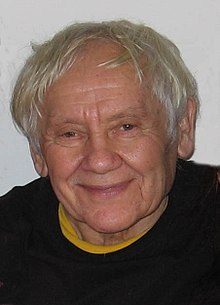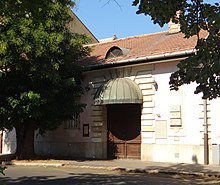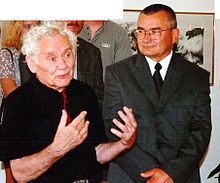Gyula Feledy
Gyula Feledy (born May 13, 1928 in Sajószentpéter , † July 3, 2010 in Miskolc ) was a Hungarian graphic artist and artist. He lived and worked in Miskolc since 1955. In addition to national and international awards, in 1978 he received the Kossuth Prize , the highest Hungarian state award. In 1984 he became an honorary citizen of the city of Miskolc, in 1989 he received the award for "Great Artist" and in 1994 the Order of the Republic of Hungary.
Life
Feledy was born into a family of miners in the town of Sajószentpéter in Borsod-Abaúj-Zemplén County . His father came from Ajnácskő (Pirsenstein), which belonged to the Kingdom of Hungary until 1919 and was added to the newly formed Czechoslovakia by the Treaty of Trianon . After losing his home, Feledy's father settled in Sajószentpéter. After the early death of their father, Feledy and his older brother were forced to work in the mine. He went to the elementary school in Miskolc, but the rest of the school course was interrupted by the turmoil of the Second World War. Through a radio call in 1946 he heard of the approval of the National Association of Universities for Reform Education (NÉKOSZ) and the Gyula Derkovits Academy of Fine Arts. Feledy submitted three papers, which were accepted, at which time he was still completing the Barnabás High School with the help of the pay packet from his ongoing work in mining. At the academy founded by János Kmetty and András Beck , teachers such as Máriusz Rabinovszky , Ernő Kállai , Sándor Bortnyik , Ferenc Medgyessy and Major Tamás trained the students. Since Beck's wife was the secretary of the influential communist politician László Rajk , he often stopped by the academy. When Rajk came under suspicion in the course of the Stalinist purges and was finally executed in 1949, the academy had to close and was incorporated into the Hungarian Academy of Fine Arts in Budapest .
With the Academy of Fine Arts, Feledy and his circle of artists wanted to continue their studies abroad, although further work at the Collegium Hungaricum in Rome had already been promised. But the political situation of 1949 no longer allowed any connections to the West. Therefore, Feledy graduated from the Cracow Academy of Fine Arts in Poland in 1953 . It was there that he met his Polish wife Szabina, a musician. Following his extensive training, he celebrated great international success. In 1955 he moved to Miskolc and in 1958 received the Derkovits scholarship from the Hungarian Ministry of Culture. In 1988, on his 60th birthday, the city of Miskolc dedicated a permanent exhibition to him in the Rákóczi House, a restored and listed property from the 17th century in which around 200 paintings and graphics by the artist are on display. The National Graphic Biennale initiated by Feledy also takes place there. Feledy was buried in Miskolc in the public cemetery at St. Peter's city gate in a grave of honor.
plant
Feledy initially dealt with the graphic work of historical personalities and studied the techniques of French artists of the 18th and 19th centuries. After completing his studies, he became the leader of a new generation of graphic designers in Eastern Europe from the late 1950s. After an initial phase in which he devoted himself to a strict classical style, his work became increasingly abstract. He later stated that abstraction was his way through communism. After the fall of the Berlin Wall , there was an increasing number of works that were clearly oriented towards realism, but always left space for fiction and intellectual freedom. Picasso's influence can be seen in a number of works, but Feledy found his subject, among other things, in the implementation of Christian and Hungarian material as well as from his own biography. In addition to independent works, the artist also illustrated books. In 2009 he exhibited in Germany.
Works exhibitions
In addition to the permanent exhibition in the Feledy House on Deák Square, which opened in 1989, some collections have works by the artist. Including the Municipal Gallery and the Otto Herman Museum in Miskolc, the Hungarian National Gallery in Budapest and the Munkácsy-Mihály Museum in Békéscsaba .
Important international exhibitions
- 1952: Krakow , Poland
- 1953: Oslo , Norway
- 1960: International Biennial of Graphic Arts in Lugano , Switzerland
- 1965: International Biennial of Graphic Arts in Ljubljana , Yugoslavia
- 1966: XXXIII Venice Biennale, International Biennale of Graphic Arts in Krakow; Exhibition in Tokyo , Japan ; Exhibition at the Collegium Hungaricum, Vienna, Austria; Exhibition at the Hungarian Institute, Prague , Czechoslovakia
- 1967: International Biennial of Graphic Arts in São Paulo , Brazil ; Exhibition at the Hungarian Academy in Rome , Italy
- 1971: Katowitz, Poland
- 1973: Turin , Italy
- 1974: Tampere, Finland
- 1980: Hungarian Institute, Berlin , GDR
- 2009: "The 'Black Art' in Hungary", Aschaffenburg Castle Museum (with Lajos Szalay and Béla Kondor)
National solo exhibitions
- 1965: Dürer's Hall, Budapest
- 1974: Jozsef Attila Library, Miskolc
- 1974: Helicon Gallery, Budapest
- 1975: Cultural Center of the County, Salgótarján
- 1976: Mini-Gallery, Miskolc
- 1979: Art Gallery, Budapest
- 1980: Municipal Gallery, Kazincbarcika
- 1980: Csók Gallery, Budapest
- 1980: Mini-Gallery, Miskolc
- 1985: Vigadó Gallery, Budapest
- Since 1988: permanent exhibition in the Feledy House, Miskolc
- 2004: Municipal Gallery, Kazincbarcika
- 2005: City Library, Miskolc
Further awards
- 1952: Culture Prize during the Helsinki Olympics
- 1960–1966: Mihály Munkácsy Prize
- 1965: Prize of the 3rd National Graphic Biennale, Miskolc
- 1994: Commander of the Order of Merit of the Republic of Hungary
Book illustrations
- Klára Fehér: Oxygenies . Corvina Kiadó, Budapest 1974
- István Demján: Kemény úton . (Collection of poems) Edelény 1992
literature
- Sándor Láncz: Feledy Gyula . Képzőművészeti Kiado. Budapest 1983. ISBN 9633362660
- István Dobrik: A humánum ereje - Feledy Gyula 80 éves. Miskolc, Könyvheti újság, II. Rákóczi Ferenc Megyei Könyvtár. P. 20. (September 27, 2008)
- István Varga: Grafikus ikonizáció - költői szó Feledy-rajzokon. Miskolc, Miskolci Keresztény Szemle, No. 1/5, pp. 44-46. (May 24, 2006)
Individual evidence
Web links
| personal data | |
|---|---|
| SURNAME | Feledy, Gyula |
| BRIEF DESCRIPTION | Hungarian graphic artist |
| DATE OF BIRTH | May 13, 1928 |
| PLACE OF BIRTH | Sajószentpéter |
| DATE OF DEATH | July 3, 2010 |
| Place of death | Miskolc |


